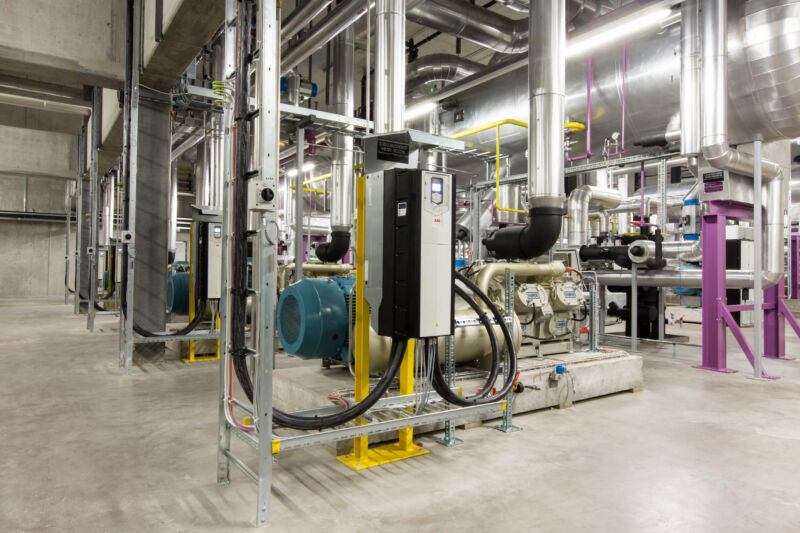One of the key messages to emerge from the COP26 UN Climate Change Conference in Glasgow is that reducing energy consumption and CO2 emissions is easily possible with technology that exists today. That is especially true for the vast numbers of motors used in industry. Tuomo Hoysniemi, President of ABB Motion’s Drive Products Division, explains how adopting variable speed drives (VSDs) and high-efficiency motors can boost both sustainability and profits.
As the International Energy Agency (IEA) stressed in its May 2021 roadmap for the global energy sector, improvements in energy efficiency are essential to a sustainable future. Importantly, the IEA has identified energy efficiency as the first fuel in tackling the enormous challenge of climate change and achieving net zero carbon emissions by 2050.
Systems driven by electric motors are an obvious place to start, as they consume around 45% of the world’s electricity and account for about 70% of industry’s consumption. Furthermore, the number of motors is expected to double by 2040. They are found everywhere, from heating, ventilation and air conditioning systems to factory production lines, food and beverage plants, and pumping equipment for water treatment and supply.
Combine drives and high-efficiency motors for next–level energy saving
In typical applications, and especially when compressors, pumps and fans are involved, introducing a variable speed drive (VSD) can cut a motor’s energy consumption by 25% or more. It works by controlling and optimising motor speed and torque to meet changing requirements. Without a VSD, the motor runs constantly and uneconomically at full speed, regardless of need, or has to be slowed down by mechanical controls which wastes energy.
When a VSD is paired with a modern, high-efficiency motor, the overall result is even greater energy economy. Regulatory pressure, including the demands of the EU’s Ecodesign Regulation, is gradually removing the less efficient motor options. In July 2021, a new minimum efficiency standard, IE3, came into force for a wide range of industrial motors. From July 2023, some motor types will have to meet a higher rating of IE4.
However, it’s possible for industry to futureproof operations by choosing the even more efficient IE5–rated technology that is already available today. This is made possible by pairing a VSD with an IE5 synchronous reluctance (SynRM) motor. Compared to induction motors, which are the industry norm, a SynRM and VSD package saves on energy consumption, downtime, maintenance and other ongoing costs.
Today, the number of industrial motor-driven systems deployed globally is estimated at 300 million. Most of these are over ten years old and outdated in design. Experts believe that replacing them with optimised, high-efficiency drive and motor packages would make a big difference – reducing the world’s electricity consumption by as much as 10%.
An easy transition
Moving up to VSD and SynRM efficiency is easy, whether by retrofitting the technology into existing installations or incorporating it into new OEM designs and projects. The motors slot into the same industry standard frames as their induction motor predecessors, with no need for mechanical modifications. The VSDs are also ready to go, with inbuilt intelligence and plug-and-play simplicity.
The cost of upgrading to a VSD and IE5 SynRM package can be justified easily on the basis of energy savings alone. Although the purchase price is a little higher than that of an IE3 motor and drive, lower electricity bills will quickly refund the difference – often in as little as a year.
This was neatly illustrated by the Campbell’s food company, which recently worked with ABB to replace old, inefficient motors in compressors and cooling systems at an Australian plant. It cut energy consumption by 14% and CO2 emissions by 131 tonnes, annually, while paying back the investment within 12 months.
In 2021 ABB launched the Energy Efficiency Movement. It’s a multi-stakeholder initiative to publicisehow advanced motor and drive technogies can mitigate climate change and to promote collective action to reduce energy consumption worldwide. Alfa Laval, the company that delivers sustainable products and solutions for customers in energy, marine, and food and water, used its platform at COP26 to publicly join the movement and commit to a 5% energy efficiency improvement in its operations by 2023 compared to 2020.
On the road toward net zero emissions, highly efficient motor and drive technology gives industry a head start. By making operations more energy-efficient, productive and profitable, decarbonization becomes economically viable for business while at the same time benefiting the planet.
https://www.energyefficiencymovement.com/en/



